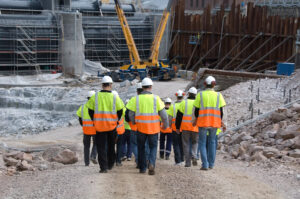Canada’s construction industry is at a critical juncture, facing a dual challenge of labour shortages and a rapidly aging workforce. These issues are not just industry-specific; they are key factors in Canada’s broader housing and economic crises. If left unresolved, the country’s ability to meet the growing demand for housing and infrastructure projects will be severely hampered. As new government policies come into play, it’s more important than ever for workers, companies, and immigrants to adapt.
The Canadian construction industry, historically contributing up to 7% of the nation’s GDP during peak infrastructure periods, is facing a massive labour shortage. With 20% of the workforce expected to retire in the next decade, there are concerns that these vacancies will significantly delay or halt housing and infrastructure projects. For example, Ontario alone is expected to lose 80,000 construction workers to retirement by 2031, even as the province aims to build 1.5 million homes to meet housing demand.

In 2023, 20,000 unfilled construction jobs in Ontario—a figure that illustrates the severity of the problem on a national scale. More alarming is the fact that, between June and July 2024, 45,000 construction jobs were lost not due to reduced demand but because workers were leaving the industry faster than they could be replaced. This creates a cascading effect, delaying project timelines, increasing costs, and ultimately making it harder for the government to address the current housing crisis.
The impact of these labour shortages is not just felt in construction companies but throughout the entire housing supply chain. From workforce availability and the recruitment of skilled labour to the actual development and timely delivery of housing units, each link in the chain is strained by the lack of workers. This directly impacts the affordability and availability of housing in Canada, exacerbating the current crisis.
Statistics Canada highlights that, while Canada continues to meet its annual immigration targets, it is losing workers faster than it is gaining them** in key sectors like construction. This suggests that the current immigration system is not optimized for Canada’s labour market needs, particularly in industries that require skilled trades.
Immigration is a crucial factor in solving Canada’s labour shortage, but the current system has struggled to funnel enough workers into the construction industry. Only 2% of newcomers are entering construction-related careers, with provinces like British Columbia and Saskatchewan leading the way in attracting immigrant workers to these trades. However, even these provinces are still falling short of their labour needs.
 As Canada grapples with its growing housing crisis, it’s clear that more needs to be done to ensure a steady flow of workers into the construction industry. This means not only improving immigration policies to attract skilled tradespeople but also developing domestic programs to encourage local workers, particularly women and young people, to consider careers in construction.
As Canada grapples with its growing housing crisis, it’s clear that more needs to be done to ensure a steady flow of workers into the construction industry. This means not only improving immigration policies to attract skilled tradespeople but also developing domestic programs to encourage local workers, particularly women and young people, to consider careers in construction.
At Directpath Canada, we understand the challenges facing both employers and workers in this ever-evolving landscape. We are committed to adapting our services to help companies find the talent they need and to assist individuals in navigating the complexities of Canada’s immigration system. Directpath Canada has helped hundreds of skilled workers successfully navigate Canada’s immigration system to fill essential roles in construction and other industries. By working with a licensed and qualified immigration consultant, individuals and companies can better understand and utilize the immigration pathways available to meet Canada’s labour demands.
Information Source: Policy Magazine










